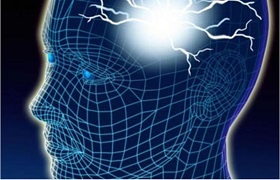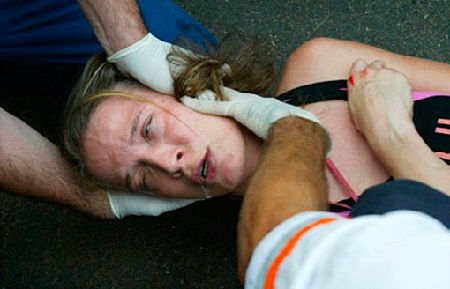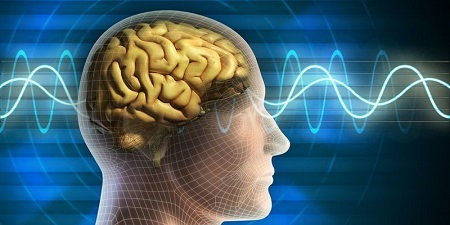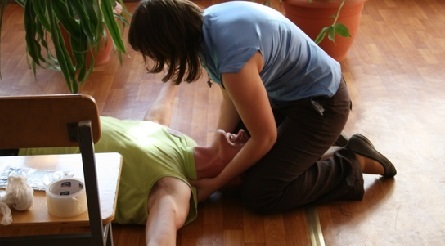 What is this: epilepsy is a mental nervous disorder that is characterized by repeated seizures and is accompanied by various paraclinical and clinical symptoms.
What is this: epilepsy is a mental nervous disorder that is characterized by repeated seizures and is accompanied by various paraclinical and clinical symptoms.
In this case, between the attacks, the patient can be absolutely normal, no different from other people. It is important to note that a single seizure is not yet epilepsy. The diagnosis is made to a person only when there were at least two seizures.
The disease is known even from ancient literature, it is mentioned by Egyptian priests( about 5000 BC), Hippocrates, Tibetan medicine doctors, etc. In the CIS, epilepsy was called "falling sickness", or simply "falling".
The first signs of epilepsy can occur between the ages of 5 and 14 years old and have an increasing character. At the onset of development, a person may develop mild seizures with intervals of up to 1 year or more, but over time the frequency of attacks increases and in most cases comes to several times a month, their character and severity also changes over time.
Reasons for
What is it? The causes of epileptic activity in the brain, unfortunately, are not yet clear enough, but are supposedly related to the structure of the brain cell membrane, as well as the chemical characteristics of these cells.
Epilepsy is classified as having an idiopathic appearance( if there is a genetic predisposition and no structural changes in the brain), symptomatic( if a structural defect in the brain is detected, for example, cysts, tumors, hemorrhages, malformations) and cryptogenicdisease).
According to WHO data around the world, about 50 million people suffer from epilepsy - this is one of the most common neurological diseases on a global scale.
Symptoms of epilepsy
In epilepsy, all symptoms occur spontaneously, less often provoked by bright flashing light, loud sound or fever( fever above 38C, accompanied by chills, headache and general weakness).
- The manifestations of generalized convulsive seizure of are in general tonic-clonic convulsions, although there may be only tonic or only clonic convulsions. The patient falls down during the fit and often receives significant damage, very often he bites his tongue or misses the urine. The fit basically ends with an epileptic coma, but there is also an epileptic excitement, accompanied by a twilight obscuration of consciousness.
- Partial attacks of occur when a hot spot of excessive electrical excitability is formed in some particular area of the cerebral cortex. Manifestations of a partial attack depend on the location of such a focus - they can be motor, sensitive, autonomic and mental.80% of all epileptic seizures in adults and 60% of seizures in children are partial.
- Tonic-clonic seizures .This generalized convulsive attacks, which involve the pathological process of the cerebral cortex. The attack begins with the fact that the patient freezes on the spot. Then the respiratory muscles contract, the jaws contract( the tongue can bite).Breathing can be with cyanosis and hypervolemia. The patient loses the ability to control urination. The duration of the tonic phase is approximately 15-30 seconds, after which the clonic phase begins, at which the rhythmic contraction of all the muscles of the body occurs.
- Absenses - attacks of sudden outages for a very short time. A person during a typical absance suddenly, absolutely for no apparent reason both for himself and others, ceases to react to external irritating factors and completely freezes. He does not speak, does not move his eyes, limbs and body. Such an attack lasts a maximum of a few seconds, after which it also suddenly continues its actions, as if nothing happened. The seizure remains completely unnoticed for the patient himself.
In mild form of an ailment, seizures occur rarely and are of the same nature, they are daily in severe form, occur 4-10 times in a row( epileptic status) and have a different character. Also, patients experience personality changes: flattery and softness alternate with malice and pettiness. Many have a delay in mental development.

First aid
Usually epileptic attack begins with the fact that a person has seizures, then he ceases to control his actions, in some cases loses consciousness. Once there, it is worth immediately calling an "ambulance", removing from the patient all the stabbing, cutting, heavy objects, try to lay him on his back, throwing his head back.
If there is vomiting, it should be planted, slightly supporting the head. This will avoid the ingress of vomit into the respiratory tract. After improving the patient's condition, you can give a little water to drink.
Interstitial manifestations of epilepsy
Everyone knows such manifestations of epilepsy as epileptic seizures. But, as it turned out, increased electrical activity and convulsive readiness of the brain do not leave sufferers even in the period between attacks, when it would seem that there are no signs of illness. Epilepsy is dangerous by the development of epileptic encephalopathy - in this state the mood worsens, anxiety appears, the level of attention, memory and cognitive functions decreases.
This problem is particularly relevant for children, becausemay lead to developmental lag and impede the formation of speech, reading, writing, counting skills, and the like. Incorrect electrical activity between seizures can contribute to the development of such serious diseases as autism, migraine, attention deficit hyperactivity disorder.

Life with epilepsy
Contrary to popular belief that a person with epilepsy will have to limit himself in many ways, that many roads in front of him are closed, life with epilepsy is not so strict. The patient, his family and others need to remember that in most cases they do not need even a disability registration.
The guarantee of a full-fledged life without restrictions is the regular uninterrupted reception of the medications chosen by the doctor. The drug-protected brain becomes less susceptible to provoking effects. Therefore, the patient can lead an active lifestyle, work( including at the computer), engage in fitness, watch TV, fly on airplanes and much more.
But there are a number of occupations that are essentially a "red rag" for the brain in a patient with epilepsy. Such actions should be limited:
- driving;
- work with automated mechanisms;
- swimming in open water, swimming in the pool unattended;
- self-canceling or skipping reception of tablets.
And there are factors that can cause an epileptic attack even in a healthy person, and they also need to be wary:
- lack of sleep, night shift work, daily working hours.
- chronic use or abuse of alcohol and drugs
Epilepsy in children
The true number of patients with epilepsy is difficult to establish, as many patients are unaware of or conceal their disease. In the USA, according to recent studies, at least 4 million people suffer from epilepsy, and its prevalence reaches 15-20 cases per 1000 people.
Epilepsy in children often occurs with an increase in temperature - about 50 out of 1,000 children. In other countries, these indicators are probably about the same, since the incidence does not depend on sex, race, socioeconomic status or place of residence. The disease rarely leads to death or gross violation of the physical condition or mental capabilities of the patient.
Epilepsy is classified according to its origin and type of seizures. There are two main types of origin:
- idiopathic epilepsy, in which the cause can not be identified;
- symptomatic epilepsy associated with a particular organic brain damage.
Approximately 50-75% of cases are idiopathic epilepsy.
Epilepsy in adults
Epileptic seizures that occur after twenty years are usually symptomatic. The causes of epilepsy may be as follows:
- head injury;
- tumors;
- aneurysm;
- stroke;
- brain abscess;
- meningitis, encephalitis or inflammatory granulomas.
Symptoms of epilepsy in adults are manifested in various forms of seizures. When the epileptic focus is in clearly defined areas of the brain( frontal, parietal, temporal, occipital epilepsy), seizures of this kind are called focal or partial. The pathological change in the bioelectric activity of the entire brain provokes generalized epileptic seizures.

Diagnosis
Based on the description of the seizures by the people who observed them. In addition to interviewing parents, the doctor carefully examines the child and appoints additional tests:
- MRI( magnetic resonance imaging) of the brain: allows you to exclude other causes of epilepsy;
- EEG( electroencephalography): special sensors applied to the head, allow to fix epileptic activity in different parts of the brain.
Epilepsy is it treated
Anyone suffering from epilepsy is tormented by such a question. The modern level in achieving positive results in the field of treatment and prevention of disease, allows us to state that there is a real opportunity to save patients from epilepsy.
Forecast
In most cases, after a single attack, the prognosis is favorable. Approximately 70% of patients on the background of treatment come remission, that is, seizures are absent for 5 years. In 20-30% seizures continue, in such cases, often requires the simultaneous administration of several anticonvulsants.
Treatment of epilepsy
The goal of treatment is to stop epileptic seizures with minimal side effects and to guide the patient in such a way that his life is as full and productive as possible.
Before the appointment of antiepileptic drugs, the physician should conduct a detailed examination of the patient - clinical and electroencephalographic, supplemented with ECG analysis, renal and hepatic function, blood, urine, CT or MRI data.
The patient and his family should receive an instruction on taking the drug and be informed of the realistic results of the treatment as well as possible side effects.
Principles of treatment for epilepsy:
- Compliance of the drug with seizures and epilepsy( each drug has a certain selectivity for a particular type of seizures and epilepsy);
- If possible use of monotherapy( use of one antiepileptic drug).
Antiepileptic drugs are chosen depending on the form of epilepsy and the nature of the seizures. The drug is usually prescribed in a small initial dose with a gradual increase to an optimal clinical effect. If the drug is ineffective, it is gradually canceled and the following is prescribed. Remember that under no circumstances should you yourself change the dosage of the medicine or stop treatment. A sudden change of dose can provoke a worsening of the condition and an increase in seizures.
Drug treatment is combined with diet, determination of work and rest. Epilepsy patients are recommended a diet with a limited amount of coffee, spicy seasonings, alcohol, salty and spicy dishes.
Medication Methods
- Anticonvulsants, otherwise called anticonvulsants, reduce the frequency, duration, in some cases completely prevent convulsive attacks.
- Neurotropic drugs - can inhibit or stimulate the transmission of nervous excitation in various parts of the( central) nervous system.
- Psychoactive substances and psychotropic drugs affect the functioning of the central nervous system, leading to a change in mental state.
- Racetam is a promising subclass of psychoactive nootropic substances.
Non-pharmacological methods
- Surgical operation;
- Method of Vojta;
- Osteopathic treatment;
- Ketogenic diet;
- Study of the influence of external stimuli affecting the frequency of seizures, and the weakening of their influence. For example, the frequency of seizures may be affected by the regime of the day, or it may be possible to individually establish a connection, for example, when drinking wine, and then it is consumed by coffee, but this is all individually for every organism of the patient with epilepsy;

How to choose probiotics for the intestines: a list of drugs.

Effective and inexpensive cough syrups for children and adults.

Modern non-steroidal anti-inflammatory drugs.

Review of tablets from the increased pressure of the new generation.
 Antiviral drugs are inexpensive and effective.
Antiviral drugs are inexpensive and effective.



